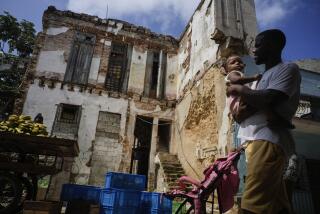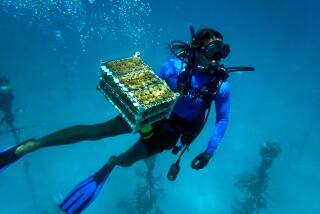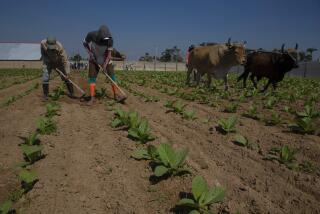Environmental Concerns Dawning in Cuba
CAYO COCO, Cuba â Well into the evenings and even on weekends, cement mixers and jackhammers hum and thump along a stretch of pristine white sand beaches that represent ground zero for Cubaâs tourism boom.
Five-star hotels are springing up in clusters on the Kingâs Garden, the archipelago off Cubaâs northern coast, and more are planned on untouched islets bordering the worldâs longest coral reef after Australiaâs.
What else is new, though, is a dawning consciousness of the environment in a society conditioned by 40 years of Communist rule to farm and manufacture with little regard for nature.
So while Cuba is turning the archipelago into a top draw for cash-toting foreign visitors, whose numbers reached 1.6 million last year, it also hopes to protect the virgin sands from tourismâs damaging footprint.
And itâs much more than simply minding the manatees.
A biodiversity-protection program, financed with $15 million from the government and $4 million from the United Nations and other donors, aims to promote growth while preserving the unusual and varied ecosystems on Cayo Coco and the archipelagoâs 2,516 other islands.
The islands northeast of Havana are home to several hundred animal and plant species native to Cuba and to one of the Caribbeanâs largest populations of pink flamingos. Turtles and manatees mingle in shallow inland waters, while migratory birds from the United States and Canada winter in mangrove forests and sand dunes.
Like much of Eastern Europe and the former Soviet Union, Cuba used to put a low premium on the environment as it strove for rapid development.
âUnless we conquer nature, nature will conquer us,â President Fidel Castro is quoted as saying during a 1970 speech in a new book on Cubaâs environment, âConquering Nature, the Environmental Legacy of Socialism in Cuba.â
The results range from waterways contaminated by sugar production waste to farm soil salinated by overzealous irrigation projects, said Sergio Diaz-Briquets, who co-wrote the book with another Cuban exile, Jorge Perez-Lopez.
Today tourism brings $1.3 billion a year into the cash-strapped country, surpassing sugar as the biggest source of hard currency, and it is likely to get much bigger if the U.S. government lifts the ban on Americans spending money in Cuba.
The Cubans believe their late start has turned out to be a boon because they can learn from the mistakes made by other Caribbean tourism destinations.
In Cayo Coco, the main resort hub on the Sabana-Camaguey archipelago, hotels are set far back from the coast to prevent beach erosion. No new hotel can be more than four stories tall, and the government studies each oneâs environmental impact before approving construction, said the biodiversity projectâs director, Nelson Espinosa Pena.
Itâs a placid contrast to crowded Varadero Beach on a peninsula off the mainland, where most beachgoers stay. Unlike Cayo Coco, Varadero, with its hotels, restaurants and souvenir stores, is open to the Cuban public.
A few yards from the main group of resorts on Cayo Coco sits the projectâs monitoring station, where scientists chart water salinity and track some of the 542 types of terrestrial insects on the archipelago.
Cuba can control tourist development because âin this country, private enterprises cannot do whatever they want like in other places,â said Alberto Perez of the U.N. Development Program, which provides money and technical support for the project.
Launched by Cuba in 1993, the project aims to establish eight protected areas within the South Carolina-sized ecosystem.
Some environmentalists worry that tourism development, even under safeguards, could threaten several species, including the queen conch, the Antilles crocodile, dolphins and manatees, which are already listed as endangered.
Boat operators at resort hotels encourage snorkelers to feed bread to the barracudas and other tropical fish darting about the purple fan coral--an environmental no-no.
Also, the government built up stone berms to connect the islands, and the disrupted water flow changed the salinity in lagoons separating the archipelago from the mainland, said Georgina Bustamente of the nonprofit Nature Conservancy, based in Arlington, Va.
She said environmentalists abroad as well as in Cuba tried to make the berm project more environmentally friendly, âbut unfortunately they decided to do the short, bad track.â
More to Read
Sign up for Essential California
The most important California stories and recommendations in your inbox every morning.
You may occasionally receive promotional content from the Los Angeles Times.










